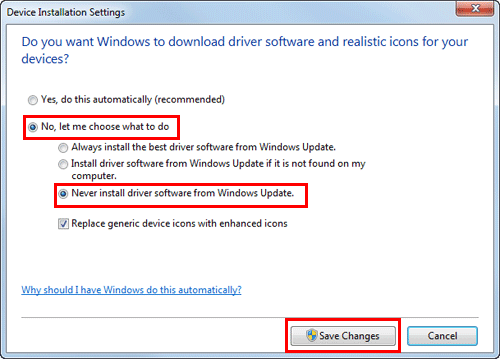
Easy Installation Process of the Printer Driver
Preparing the printer driver
Preparing the printer driver DVD
For the DVD, contact the administrator of this machine.
Checking the printer driver type
Three printer drivers for different purposes are available. Select the printer driver that meets your printing aims.
Checking the operating systems supported by the printer driver
Check that your computer meets the operating environment requirements of the printer driver.

Installing the printer driver to the computer
Configuring the installation settings on the computer
In Windows 7/8.1/10/Server 2008 R2/Server 2012/Server 2012 R2/Server 2016, you need to change the PC settings in advance.
Installing the printer driver using the installer
Connect the USB printer cable, insert the print driver DVD into the drive, and install the software by following the on-screen instructions.
Performing a test print
If necessary, perform a test print to check that printing process works correctly.

Preparation finished
Preparing the printer driver DVD
The following types of DVD and CD-ROM are delivered with this machine.
DVD and CD-ROM types | Description |
|---|---|
Driver & Utilities DVD | Contains the printer driver (PCL/PS/XPS/FAX) for Windows, printer driver for the Mac OS, screen fonts, and TWAIN driver. This also contains the page for downloading utility software. |
User's Guide CD-ROM | Contains the User's Guide. |
In User's Guide manuals, location paths of folders or files may not contain the root directory.
Checking the printer driver type
The following types of printer drivers are available. Select the printer driver that meets your printing aims.
Printer driver | Page description language | Description |
|---|---|---|
PCL driver | PCL6 | This is a standard driver for printing general office documents. Among the three drivers, this driver provides the fastest printing speed. |
PS driver | PostScript 3 Emulation | This driver is effective for high-definition printing of data created in PostScript-supporting application software from Adobe or other vendors. This driver is often used in graphics and light printing applications where good color reproducibility is important. |
XPS driver | XPS | Driver compatible with XML Paper Specification (XPS). This driver has several advantages, including high-quality reproduction of translucence. |
Checking the operating systems supported by the printer driver
The following lists the printer drivers included on the DVD supplied with this machine and the supported operating systems.
Printer driver | Supported operating systems |
|---|---|
PCL driver PS driver | Windows 7 Home Basic |
XPS driver | Windows 7 Home Basic |
* Supports the 32-bit (x86) or 64-bit (x64) environment.
Changing the installation settings (Windows 7/8.1/10/Server 2008 R2/Server 2012/Server 2012 R2/Server 2016)
In Windows 7/8.1/10/Server 2008 R2/Server 2012/Server 2012 R2/Server 2016, change the PC settings before installing the printer driver.
Open the [Control Panel] window.
In Windows 8.1/10/Server 2012/Server 2012 R2/Server 2016, while pressing the [Windows] (
 ) key, press the [X] key, and then click [Control Panel] in the displayed menu.
) key, press the [X] key, and then click [Control Panel] in the displayed menu.
In Windows 7/Server 2008 R2, click the Start menu, then click [Control Panel].
Click [System and Security] - [System].
Click [Advanced system settings] on the menu to the left.
The [System Properties] screen appears.
In the [Hardware] tab, click [Device Installation Settings].

Select [No, let me choose what to do], select [Never install driver software from Windows Update.], then click [Save Changes].
After you have installed the printer driver, change the setting back to [Yes, do this automatically (recommended)].

Click [OK] to close the [System Properties] window.
Installation procedure
Install the printer driver using the installer.
Administrator privileges are required to perform this task.
Connect a USB cable to the USB port of this machine.
For details on the cable connection port, refer to Here.
If a wizard screen appears to add new hardware, click [Cancel].
Insert the printer driver DVD into the DVD drive of the computer.
Make sure that the installer starts, and then go to Step 3.
If the installer does not start, open the printer driver folder on the DVD, double-click [Setup.exe] (in the 32-bit environment) or [Setup64.exe] (in the 64-bit environment), and then go to Step 4.
If the [User Account Control] window appears, click [Continue] or [Yes].
Click [Printer Install].
Read the license agreement, then click [AGREE].
Select your machine from [Product/Model], then click [Next].
Select [Install printers/MFPs], then click [Next].
Printers being connected via USB ports are detected.
Select this machine, then click [Next].

Select the check box of the printer driver you want to install, then click [Next].
For features of each printer driver, refer to Here.
In [Print Type Default Setting], you can select whether to install the driver that has 2-sided printing specified as the default, or to install the driver that has 1-sided printing specified as the default. By default, the driver that has 2-sided printing specified as the default is installed.
Check the items to be installed, and click [Install].
Change the printer name or print a test page if necessary, then click [Finish].
This completes the installation process of the printer driver.
Settings
Description
[Review]
Displays the installed components for checking.
[Rename Printer]
Changes this machine name if necessary.
[Property]
Sets the optional operating environment of this machine. For details, refer to Here.
[Print Setting]
Changes the default print settings of this machine if necessary. For details, refer to Here.
[Print Test page]
If necessary, print a test page to check that printing process works correctly.
When you finish installing the printer driver, configure the default settings of the printer driver. For details, refer to Here.

